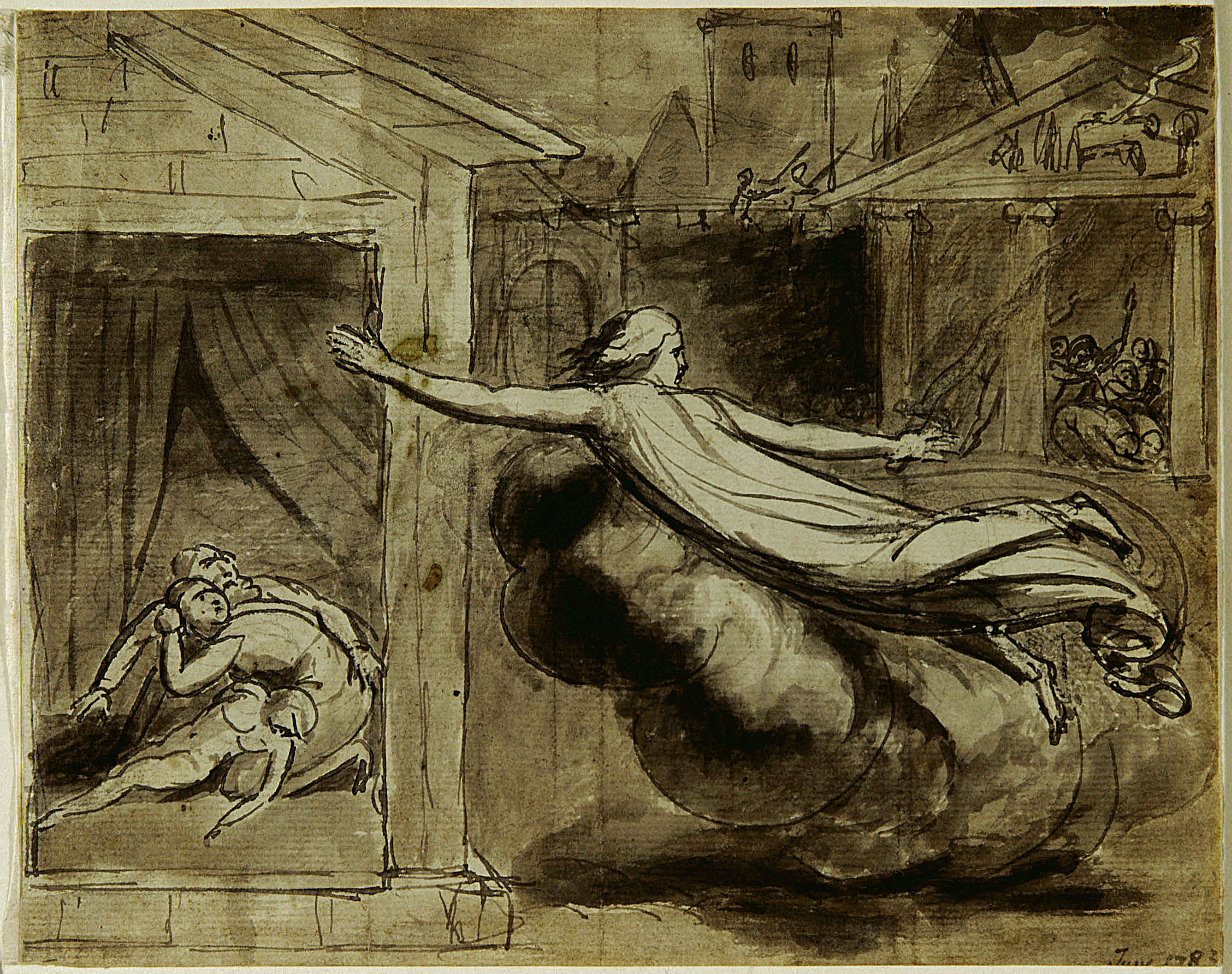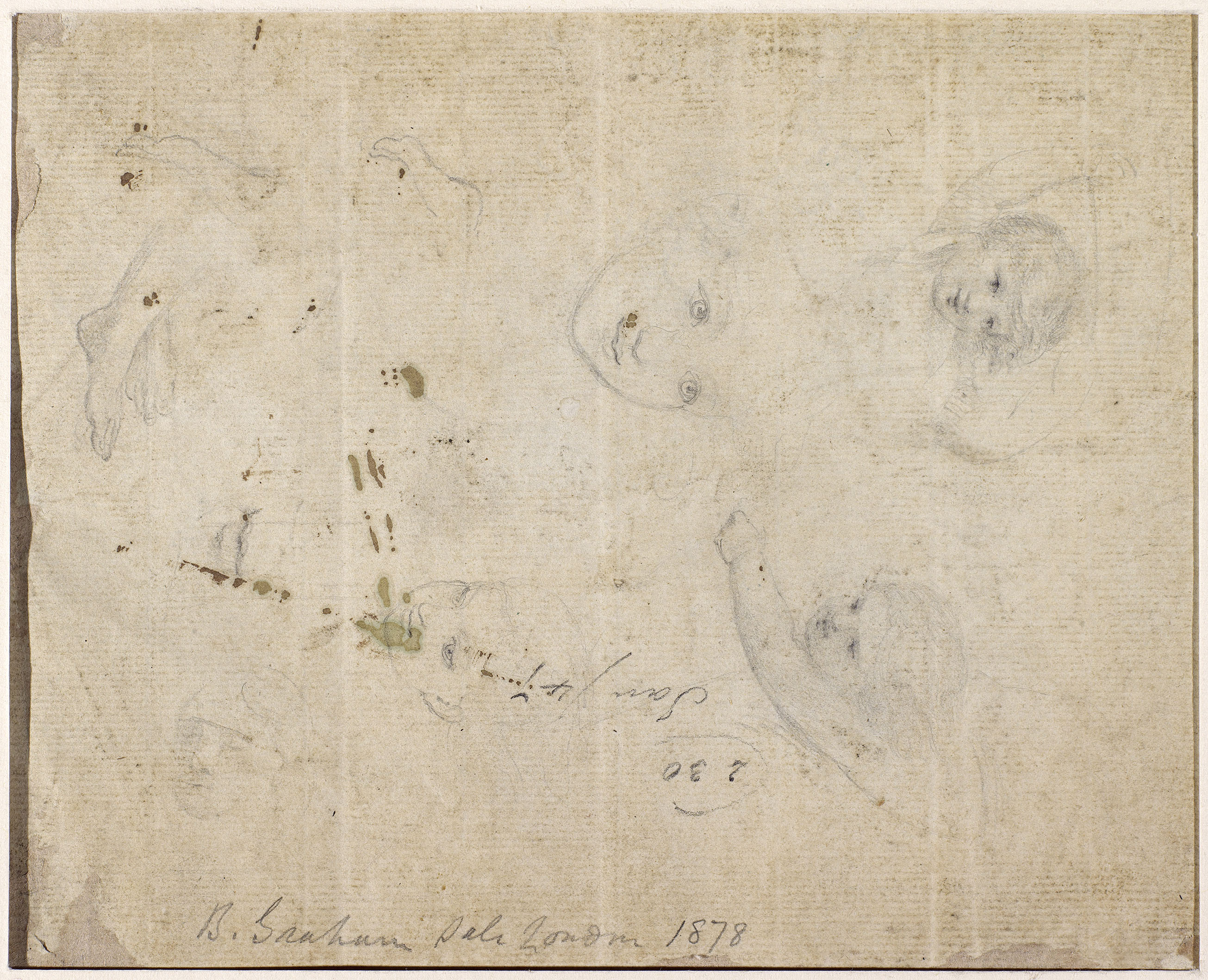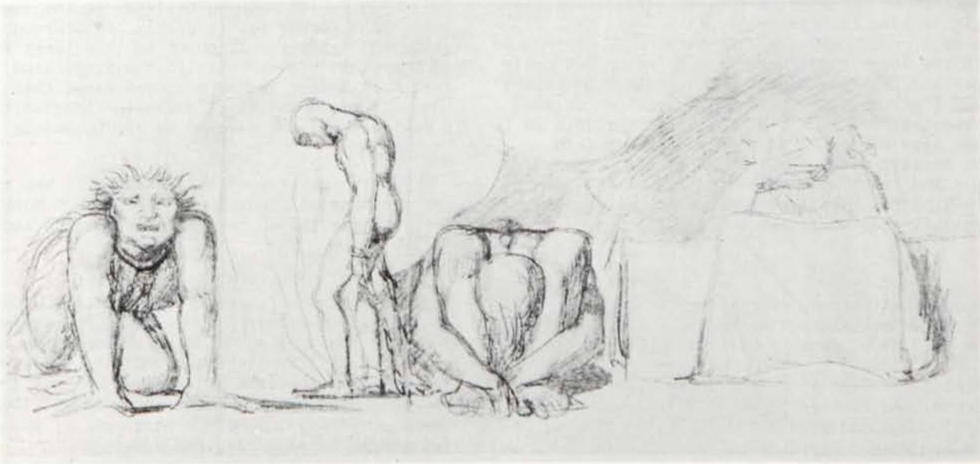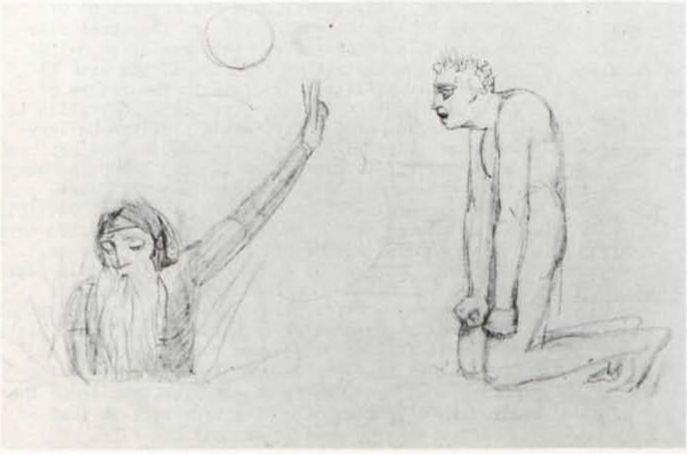NOTES
FIVE BLAKES FROM A 19TH-CENTURY SCOTTISH COLLECTION
Five Blakes from the collection of Barron Grahame, FSA, of Morphie, Scotland (or “N.B.” for North Britain, as it was called in other catalogues of sales from his collection), sold at Sotheby’s on 15 March 1878, have recently re-appeared in Scotland. Two now belong to Donald Davidson, three to David J. Black, all five coming from the collection of Robert Carfrae junr., whose father seems to have acquired them at the time of the Grahame sale, two examples being inscribed on the back with some variation of “B. Grahame sale London 1878” (see illus. 3).
The Grahame sale included two lots containing works attributed to Blake. Lot 22 consisted of six “sketches in pencil, etc., of various subjects,” and Lot 23 of “God Appearing to Adam and Eve, indian ink, fine, and another, pen and ink.” Both lots were bought, for £2.11.0 and £5.7.6 respectively, by “Chalmers,” possibly on commission for, or a pseudonym of, Robert Carfrae senr. Of the five works now known one is in pen and watercolor, one in pen and ink wash alone, and three in pencil, the first two being those belonging to Donald Davidson. Three, including the “God Appearing to Adam and Eve,” are still missing.
The watercolor (illus. 1) is what seems to be the earliest known version of “Pestilence” or “Plague,” and is a sketch for the somewhat larger watercolor, at present untraced but known from a reproduction in The Connoisseur, 93 (1934), 209, where it is said to measure 10 ¾ × 7 ¼ in. (27.5 × 18.5 cm.). The newly re-discovered work, inscribed “WB” in the lower right-hand corner (not necessarily by Blake and partly lost through trimming) and “Lord have mer [“mercy”] on us” on the door shown on the left, measures 5 7/16 × 7 5/16 in. (13.8 × 18.6 cm.), the same size as the series of illustrations to English history of c. 1779, which it also resembles in style and technique. Blake’s list of English history subjects, written in his Notebook in 1793, but probably related to the project of c. 1779, includes “The Plague” immediately before “The Fire of London,” presumably meaning the plague of 1665. David Bindman, in discussing this group of works in William Blake: Essays in honour of Sir Geoffrey Keynes, 1973 (“Blake’s ‘Gothicised Imagination’ and the History of England,” p. 46), tentatively suggests that the “Plague,” “Fire” and “Famine” of which versions were painted for Thomas Butts, in and about 1805, were originally an offshoot of the English history series; Mr. Davidson’s watercolor confirms this suggestion at least in the case of “Plague,” of which there are in all no fewer than five versions, in which the composition evolves from a rather labored neo-classicism in the manner of Benjamin West to a much more economical example of Blake’s mature style.
The recto of Mr. Davidson’s other drawing (illus. 2), in pen and wash, is similar in style and general subject though rather larger, 7 × 8 11/16 in. (17.7 × 22.1 cm.). It shows an angel, borne up by a heavy cloud, flying over a town square and brandishing a partly erased sword which seems to have set alight the temple in the background within which cower a group of inhabitants; in the foreground is a similar group, of father, mother and child, the last being apparently sick or dead. No other version of this composition is known today, but it is tempting to see it as the first sketch for the lost Royal Academy exhibit of 1784, no. 427, “War unchained by an Angel, Fire, Pestilence, and Famine following.” The date “June 1783” in the lower right-hand corner (again partly lost through trimming) lends some support to this identification, though it is not definitely in Blake’s hand. The sketch is bolder and more accomplished than “The Plague,” though Blake’s developing imaginative powers are not yet matched by his technique.
On the reverse of this drawing in pen and wash are a number of studies in pencil, much more assured in technique though less imaginative and individual begin page 6 | ↑ back to top
Of the three pencil drawings belonging to David J. Black one (illus. 4) is a sketch for plate 51 of Jerusalem, very similar to it though in reverse, but with the fascinating addition of an extra figure on the left (that is, on the right had it been included in the engraving). It measures 6 5/16 × 13 ⅜ (16 × 34 cm.). The engraved plate shows Vala, Hyle and Skofield; the additional figure, to follow a suggestion of Morton D. Paley, is probably Hand. The paper shows signs of having been folded back twice, once to eliminate this extra figure, the other time to eliminate that of Skofield as well.
Another of the pencil drawings (illus. 5) is similar in style and scale to a number of drawings associated with the illuminated books, particularly Jerusalem, but cannot be related to any one plate (see the drawing for Jerusalem pl. 37, repro. Sir Geoffrey Keynes, Drawings of William Blake, 1970, no. 55, and also his no. 50, for which see Frederic Cummings in exhibition catalogue, Romantic Art in Britain, Detroit and Philadelphia, 1968, Anne T. Kostelanetz’s review in the Blake Newsletter, 2 [1968-69], 5-6, and Frederic Cummings’ reply in same, pp. 46-48). It is a variant of a recurrent and particularly expressive motif in Blake’s art, the figure seen from the front but leaning forward so far that the hair falls away from the neck enabling one to see the bare neck and shoulders; examples are on page 68 of Vala and the figure of Eve in “The Body of Abel found by Adam and Eve” (repro. G. E. Bentley, Jr., William Blake: Vala or The Four Zoas, 1963, and Geoffrey Keynes, William Blake’s Illustrations to the Bible, 1957, pls. 15a and 15b). The figure in this drawing is particularly close to that in “Theotormon Woven,” perhaps also to be associated with Jerusalem (see Morton D. Paley, “The Figure of the Garment in The Four Zoas, Milton, and Jerusalem” in Stuart Curran and Joseph Anthony Wittreich, Jr., Blake’s Sublime Allegory, 1973, p. 128, repro. pl. 2).
In the upper right-hand corner of the sheet, which measures 7 ⅞ × 6 7/16 in. (20 × 16.3 cm.), there is a rather indistinct sketch, which seems to resemble the girl at the bottom of the pen and wash drawing for The Grave in the collection of Robert N. Essick, “The Soul exploring the Recesses of the Grave” of c. 1805 (repro. Blake Studies, 4 [Spring 1972], cover), and the suggestion of masonry behind the main figure on the sheet also recalls this composition. This variation on the theme of the expressive exposure of the back of the neck is particularly close to the figure of Grief in Fuseli’s “Melancholy,” an illustration to Il Penseroso painted for Fuseli’s Milton Gallery between October 1799 and March 1800. This has been destroyed but is known from the engraving in Sharpe’s British Theatre, 1804 (see Gert Schiff, Johann Heinrich Fusslis Milton-Galerie, 1963, pp. 94, 161, the engraving repro. pl. 52). Fuseli repeated this figure on its own for his painting of “Silence,” which was engraved by J. Burnet for the title-page of Fuseli’s Lectures on Painting, published in 1801 (repro. Schiff, pl. 53). It is often difficult to establish priorities as between Fuseli and Blake, whom Fuseli found it “damned good to steal from,” but in this case Fuseli was probably the first. However, it seems to have been Blake who added the final emotive element of the bare neck to that of the hair hanging down to conceal the face.
begin page 8 | ↑ back to topThe third pencil drawing (illus. 6), 6 5/16 × 9 ½ in. (16 × 24.2 cm.), is a version of the drawing in pencil, partly finished in watercolor, in the British Museum with the tentative title of “Hamlet and the Ghost of his Father” (1874-12-12-130; Binyon Catalogue of Drawings, no. 43 [17], where it is suggested that the watercolor may be by William Blake’s younger brother Robert). The pencil drawing is more detailed and higher in quality than that underlying the British Museum watercolor and the work seems to be a genuine, if very early and immature, sketch by William.
A clue to the identification of the subject of this drawing is tied up with the probable early history of all the Barron Grahame Blakes. These, it will be remembered, numbered eight in all, though only five are known at present. A single lot in the sale of the print-seller Joseph Hogarth at Southgate and Barrett’s, 7-30 June 1854, seems to have contained the same eight works. Lot 4624 on the eleventh evening of the sale was described as “The Destroying Angel, The Plague, Witch of Endor, etc. (8)” (meaning eight works in all). “The Plague” could well be the Donaldson version; none of the others has a better claim. “The Destroying Angel” is a good description of the drawing here identified as a sketch for “War unchained by an Angel. . . .” Although the Witch of Endor is not herself visible the composition of both David Black’s drawing and the version in the British Museum fulfills much of her description of what occurred when Saul asked her to evoke the ghost of Samuel: “I saw gods ascending out of the earth. . . . An old man cometh up; and he is covered with a mantle” (I Samuel 28: 13-14). The titles in the Hogarth sale catalogue are extremely inaccurate, but even if the identification of the subject of the two drawings as “The Witch of Endor” is not absolutely certain, it is preferable to “Hamlet and the Ghost of his Father” and close enough to reinforce the link between the Barron Grahame Blakes and the Hogarth sale. The eight works were bought, for 13/-, by “Cowieson,” a name otherwise unknown in Blake provenances, and perhaps a pseudonym or agent for Grahame.
Joseph Hogarth acquired his Blakes from Frederick Tatham (Bentley, Blake Records, p. 374), who had inherited the contents of Blake’s studio from the artist’s widow. An approximate date for Hogarth’s acquisition of his Blakes is suggested by two features of the Barron Grahame drawings. In the first place the three pencil drawings are mounted on paper watermarked “J WHATMAN 1843” or “J WHATMAN 1844”. In the second place all five drawings are inscribed either on the back of the mount, or, in the case of the unmounted “War unchained by an Angel . . . ,” on the back of the drawing itself, with a number in the 200’s followed by “Jan/47”; an example can be seen in illus. 3, the verso of “War unchained. . . . ” Each inscription is perhaps some kind of stock number followed by the date when Hogarth acquired the work (as there were only seventy-nine Blakes in his sale it is probable that the count of over two hundred included works by other artists). There is a similar inscription on the verso of a drawing at McGill University, Montreal, which seems to be the “Children at the Grave of their Parent” in lot 237 on the first evening of the Hogarth sale (the verso is repro. as endpapers to Lawrence Lande, Credo and an Open Letter to a Scientist, Montreal 1950). On the other hand there is evidence that Hogarth already had some Blakes by about 1843, so perhaps it was he who mounted this group on acquiring them from Tatham and “Jan/47” was merely the date of the supposed stock-taking. John Ruskin’s largely abortive purchase of a portfolio of Blake from Hogarth is the subject of a letter to George Richmond, who had acted as intermediary, which can be dated to about 1843 on account of Ruskin’s reference to his father’s generosity in buying works by J. M. W. Turner for him, an activity that was at its height in the years 1842-44 (see E. T. Cook and Alexander Wedderburn, The Works of John Ruskin, XXXVI [1909], 32-33, and Luke Herrmann, Ruskin and Turner [1968], pp. 20-22).

![Lord have
mer[cy] on us](img/illustrations/BUT184.1.1.WC.300.jpg)




